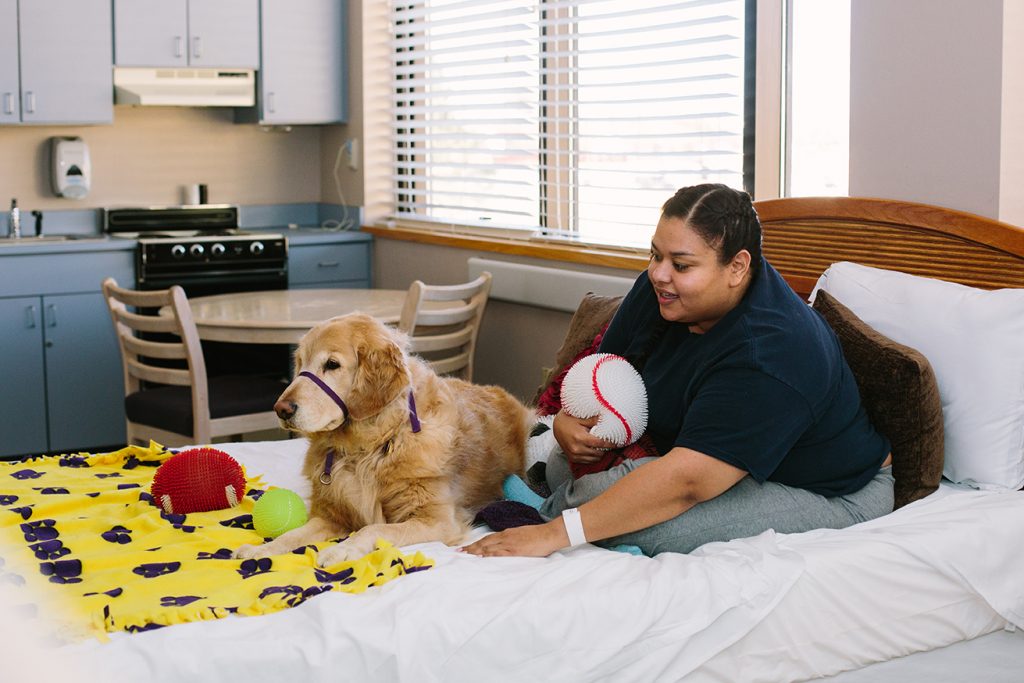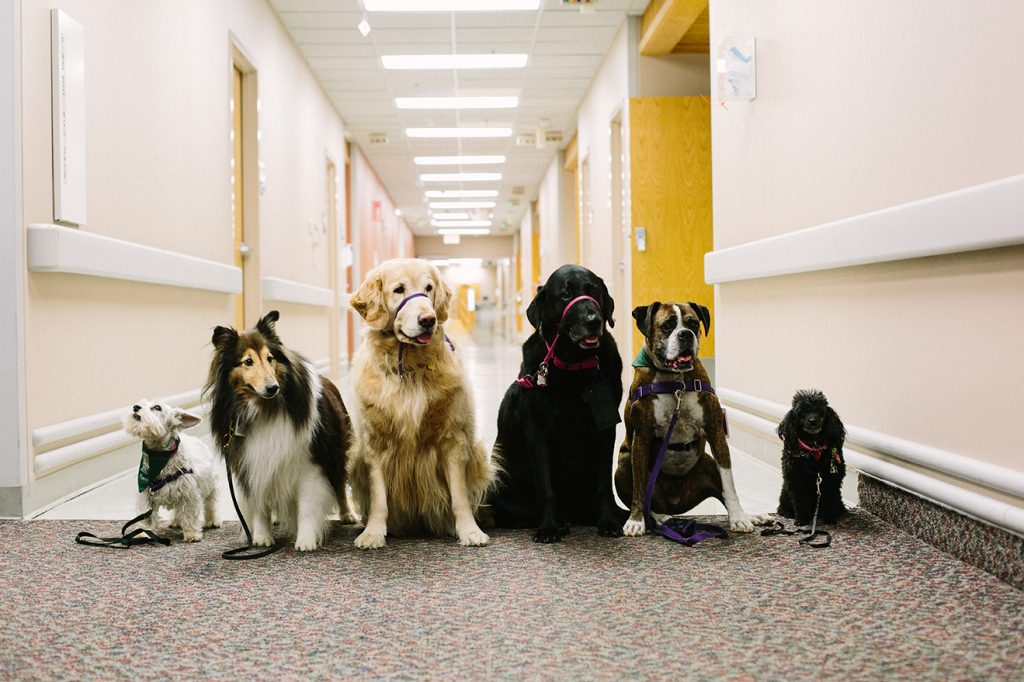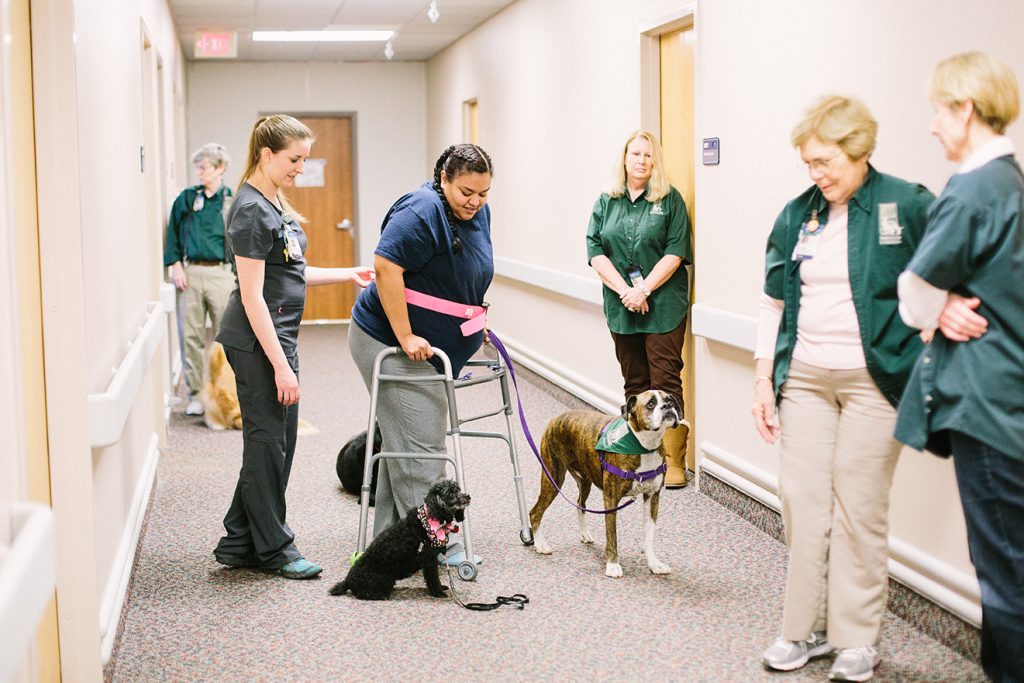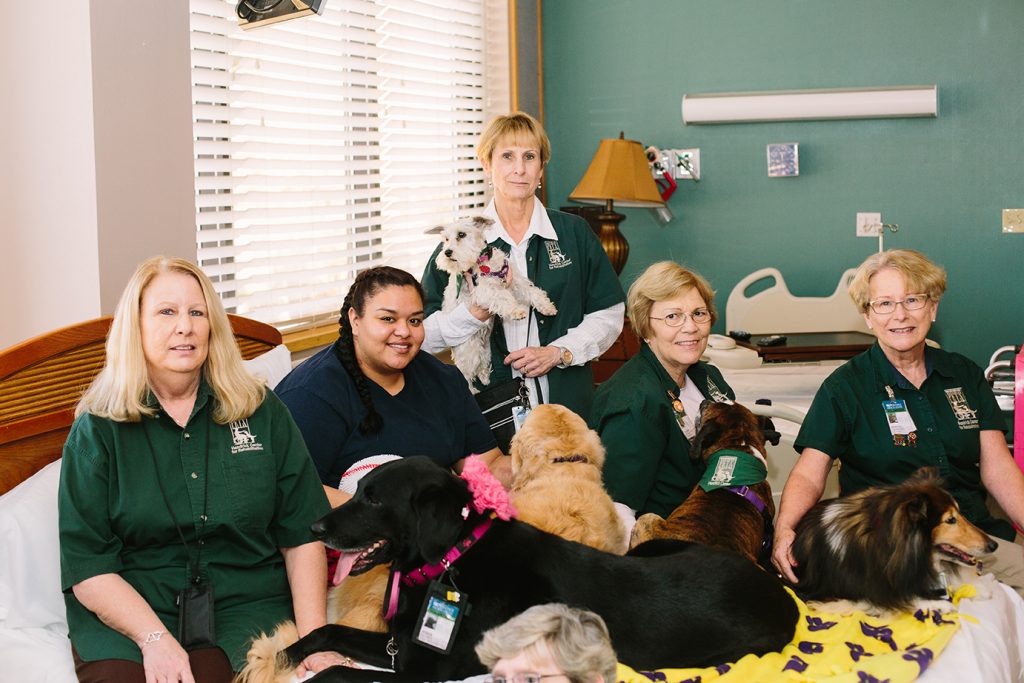Local canine companions take on key roles in therapy and patient care
By Sarah Carlson
Photography by Beth Dukes
The patient was unresponsive – had been for weeks – but that didn’t stop Revan.
Val Petronella’s Doberman, a licensed therapy dog, practically dragged her to the hospital room. There, Revan walked directly to the bedside and nudged his snout under the patient’s hand.
Petronella chatted with the family members gathered around, and they remarked how she, the patient, had loved dogs. Revan stayed put.
Then it happened: The patient began moving her hand, lightly petting Revan’s nose.
“The whole family broke down – they were all in tears,” Petronella said.
The patient hadn’t moved in weeks, but she moved for Revan. She moved for a dog.
“They were so appreciative that they could get a little bit of a reaction from her,” Petronella said. “It was very nice.”
Owners of therapy dogs have countless such stories to share about their canine companions and the difference they make in the lives of those struggling, be it from illness, disability, grief or anxiety.
A dog can be a calming presence in the midst of storms, literal or otherwise – dogs don’t judge, and they don’t refuse love. A dog can distract a person from emotional or physical pain and perhaps persuade them to do things they don’t want to do, like therapy exercises. A dog technically says nothing, but to many, they communicate so much.
“They just know things – they sense things,” said Barbara O’Neil, who has two boxers, Roscoe and Danni, both trained as therapy dogs.

Both Abilene Regional Medical Center and Hendrick Health System have pet therapy programs. ARMC works with a group of Therapy Dog International (TDI)-certified and -insured dogs and owners who visit patients at the hospital as well as other locations. Dogs in the Pet Enhanced Therapy Services (PETS) program at Hendrick Center for Rehabilitation are used to visit with patients as well as help during physical therapy sessions.
“Dogs do wonderful things,” said Donna McGhee, coordinator for the PETS program. “They are a secret weapon, and that’s what we call them.”
Intelligence and emotional understanding in dogs and other animals can be hard to track scientifically. Empathy in humans can be researched because humans are able to report how they feel, said Brian Hare, an associate professor in the Department of Evolutionary Anthropology and the Center for Cognitive Neuroscience at Duke University, in a 2013 interview in Scientific American magazine.
“But there is definitely something special about the bond we have with dogs,” he said. “Their ability to read our communicative gestures makes them seem ‘in tune’ with us. And their attentiveness to our every move can’t help but make us feel special. There is one study that shows that dogs would prefer to spend time with humans than their own species, which is unusual for an animal.
“Every dog owner is familiar with that rise in spirits as a thumping tail greets you at the door, and from the enthusiasm dogs have for us, it’s hard to believe the feeling isn’t mutual.”
Many animals can be therapy or service animals, from cats to birds to rabbits, and you can find them everywhere, from nursing homes to schools to disaster areas. But dogs are the most common because they are arguably the most relatable.
“It’s emotional therapy,” O’Neil said.
Once, she was called to a hospital room by a woman whose husband’s health was failing.
“Roscoe got up on the bed and laid across him” to give him comfort, she said. “And I cried, like I’m crying now. That’s your payday, you know?”

Making rounds
Roscoe and Danni are two of the dogs certified under TDI that visit ARMC. Petronella is a trainer who helps coordinate the group of volunteers – they also are part of the TDI program Tail Waggin’ Tutors in which children read to dogs – along with Chazman Dobbins, volunteer services coordinator for the hospital.
One Saturday morning in January, O’Neil, Roscoe and Danni lead the pack of therapists that day – including Mattia Bray and her chocolate Labrador, Layla; Debbie Freeman and her goldendoodle, Reese; and Rosanna Day and her Great Pyrenees, Finley.
O’Neil knocks on patients’ doors, then opens them a crack and asks brightly, “Do you like dogs?” If the answer is yes, in go the canines, just for a minute or two. All are calm and ready to be loved on, key requirements for therapy dogs.
All breeds are welcome, both Petronella and McGhee say, from chihuahuas to pit bulls and Pomeranians to Great Danes. Both groups boast dogs of all sizes – 10 so far with Petronella and 20 with McGhee.
Temperament is key for a therapy dog. They and their owners both go through training, but it’s not enough to know commands. A dog has to have top-notch social skills and be able to handle new and sometimes chaotic situations, from busy hallways full with wheelchairs to elevators crowded with other therapy dogs.
Bray remembers one of her testing sessions with Layla. The activity: A sea of walkers.
“Layla’s a retriever. What’s on the bottom of walkers? Tennis balls,” she said with a laugh.
She could feel Layla wanting to fetch, but she had to learn to ignore the enticing toys. The same with food or other objects on the ground. A therapy dog has to know that when they’re on the clock, it’s time to focus, not play.
Each dog in Petronella’s group is adorned with gear, from special tags to bandanas, indicating they are therapy dogs. They also have nametags.
“When you get their gear out, they know they’re going to work,” Petronella said. “Going to the park is a whole different reaction than going to work or to training school.”
The dogs at both hospitals are required to be bathed and groomed before each visit. Humans work at the dog’s pace, not the other way around. Some of the dogs can only work about 30 minutes, and then they’re done, Petronella said. Some can work hours. O’Neil remembers working four to five hours at a time with her boxers when they were younger.
“It takes so much out of them emotionally,” Bray said. “At the nursing home, we have four friends we visit. Our visits are maybe two minutes apiece. Layla will go home and sleep for three hours. She’s given so much of herself.”
At Hendrick, the dogs are integrated into certain types of therapy, McGhee said. The processes aren’t always fun and can be painful – repeating words to practice speech, or moving limbs centimeters at a time, or having skin prodded to provide stimulation.
“After a while, the patient gets pretty fed up with it,” McGhee said. “It’s boring, or it hurts. If you put the dog there, you can ask the patient to reach for the dog, for example. They don’t see it as therapy; they see it as petting the dog.”
The dogs are a stress reliever for a facility’s staff members as much as they are for family and patients. During the January visit, more than one doctor or nurse pauses to scratch the head of a dog and smile, enjoying a brief break from what can often be a trying profession.
“It’s a parade!” exclaims someone from one of the rooms as the menagerie makes its way down the halls.
“My daughter used to have a boxer,” said one man walking past the group. “I didn’t like that dog, it was smarter than I was.”
“You hear the stories,” Bray said after he leaves. “It makes them forget.”
“It’s great to see them smile,” Freeman said.

A sixth sense
Whether they are required to sit still as part of specific task, or if they are free to cuddle, the dogs always surprise their owners by appearing to be the ones calling the shots.
McGhee laughs she remembers her former therapy dog, Hoana, a Labrador and golden retriever cross and “big black fluffy thing.” Hoana had a look about her, McGhee said, that seemed to relay to her human, “The sooner you catch on, the better.”
“She had the innate ability – if you had somebody who was sitting in a chair who needed to go two more centimeters, she knew how to stand and where,” McGhee said. “She knew who needed her attention.”
Once, while at Abilene Regional’s ICU, Layla began dragging Bray down the hall so abruptly Bray almost lost hold of the leash.
“I was ready to correct her, but she made a beeline for this young woman and planted herself in front of her,” Bray says.
The woman sat down in front of Layla. “You knew I needed this, didn’t you?,” she said.
Bray’s eyes began to water, and she asked the woman if she was there to visit a family member. Yes – her grandfather was in ICU, and he wasn’t doing well.
“There were people packed in the hall, and she went for that one person,” Bray said.
She knew she was needed, so she went to work.
Another time at a nursing home, Layla refused to leave the bed of woman with Alzheimer’s who was nearing her time.
“I had to yank her out of bed,” Bray said. “And I got a call shortly thereafter; the woman had gone.”
“It’s the way they sense people’s feelings,” she said, shaking her head in wonder. “I can’t explain it.”
























Is there a trainer that can contact us to get my grandsons dog trained to be a therapy dog or an emotion support dog? My grandson was gifted her by a lady here in Abilene due to his extreme anxiety. She has helped him tremendously. She is a full blood German Shephard and very calm.
I’m also interested in getting a trainer for my dog that I recently rescued. she is so calm she would do well helping others, and she needs something productive to do!